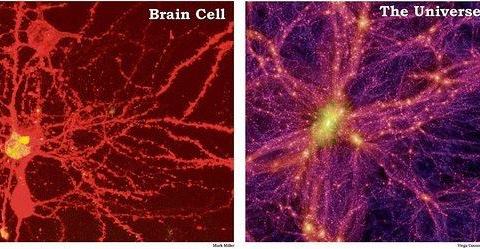The Power of Networks: Fractals of Complexity

What’s the Big Idea?
All religions, arts and sciences are branches of the same tree.” – Albert Einstein
In the latest RSA Animate production, Manuel Lima explores the power of network visualization in our increasingly complex world. A senior UX design lead at Microsoft, Lima explains how the world wide web we’ve mapped out on the Internet is eerily similar to many natural phenomenon in the world and universe at large.
Watch here:
Lima starts with the network’s anteceding knowledge classification system, “the tree”. Dating back to the earliest religions, knowledge trees embody how humans perceive the world – with order, symmetry, hierarchy, simplicity, balance, and unity. However, there has been a paradigm shift whereby the complexities of our modern world now exceed the capacity of the tree diagram, instead manifesting as a web of connections.
The examples of this shift go on-and-on; the more we examine worldly phenomenons the more we observe these intricately structured networks. Wikipedia and other open-sourced projects display these characteristics, as do ecosystems of both the animal kingdom and of man.
Even further, the classic tree of life we all know and love has proven to be more congruent and connected then Darwin originally observed. Scientists recently discovered a dense network of bacteria that effectively link together very disparate species on the tree of life, such that each branch is ultimately one and the same. Considering that 90% of the human body is bacteria, this is a finding that truly touches us at our core. As such, the tree of life has now evolved into what the scientists are calling “the web of life.”

Lima concludes with a question: “is there such a thing as universal structure?”
The most tangible comparison is of the neural network of the brain and the intergalactic network of the cosmos. The human brain weighs about 3 pounds and fits between our ears, whereas the universe is, well, a lot bigger. Yet despite this contrast in size, when both of these natural structures are mapped out as a series of connections, they look nearly identical (see picture above). You can take this even one step further: while the universe is infinitely larger than the brain, and the brain is infinitely larger than a cell, cells seem to produce the same pattern of complexity!
These and more examples can be seen at Lima’s website www.visualcomplexity.com.
The 11 minute video concludes with Lima suggesting that in order to understand the patterns emerging all around us, we must embrace the notion of renaissance, polymathic thinking. Indeed, the interconnectedness of our social web can be a big part of our ability to cultivate interconnected thinking. It stands to reason that Lima, a senior design lead at Bing, had something to do with its latest edition to the algorithm, which now includes a social component to finding things on the web.
The more we get outside of our personal online filter bubbles, as Eli Pariser describes, the more we can engage with different ways of thinking, and perceive the world as what it truly is: fractals of infinite possibility.
What’s the Significance?
Originally observed while he was a visiting Harvard Research Fellow at IBM in 1979, the late Benoit Mandelbrot discovered a pattern that came to be known as the Mandlebrot Fractal Set. Arguably one of the most underappreciated discoveries in history, the Mandlebrot Set is a mathematical function, described simply as: z = z^2 + c, that depicts an infinite series of fractals, which potentially compose all areas and aspects of life as we know it.
(first deviation at 1:15)
The M-Set is interesting for a number of reasons. Not only does it produce majestic artwork (seen above), but it represents an idea that is potentially so large in scale that it resides on the level of unknowing that is reserved mainly for the string theorists. Nonetheless, the repetitive patterns Lima describes in ‘The Power of Networks’ are exactly what the Mandlebrot Fractal Series represents: a basic sequence that continues infinitely in all directions. While this idea is a big one, and quite far out there in terms of intellectual umph, it’s something this writer believes needs to be brought back into the mainstream conversation.
According to Mandlebrot and his disciples, the Fractal series could potentially be a mathematical equation that exists ubiquitously in the universe. Mandlebrot fractals have already been replicated to mimic structures in the physical world, and Lima’s visualization of all these various networks is proof that such continuums exist in the unseen world as well. From the itty-bitty workings of a cell, to the activity in cities, to the overwhelmingly-massive configuration of the universe, we see these patterns everywhere. Is the Mandlebrot Fractal Set the underlying formula behind what we are observing?
While we currently don’t know the answers to this and many other of the universe’s most enigmatic questions, it is quite remarkable we have come this far. The 3lb piece of meat that drives our cognition has collectively enabled us to walk on the moon, sequence the human genome, and create hilarious lolcats. But despite our accomplishments, it seems there is still an infinite number of deep mysteries left to be answered.
We must remain determined, as two recent scientists pointed out on stage at TED. String theorist Brian Greene explains: “we are living through a remarkably privileged era, when certain deep truths about the cosmos are still within reach of the human spirit of exploration.” And biologist Nathan Wolfe, who says “don’t assume that what we currently think is out there is the full story… go after the dark matter, in whatever field you choose to explore.”
Whether you are linking the Mandlebrot Set to Lima’s Network visualizations or solving the Theory of Everything, our planet’s collective evolution rests on our individual contributions to our networks. So whatever your fractal of choice, explore its depth to infinity and beyond… and make sure you tweet about it.





